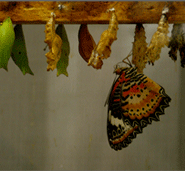Dhrupadi Ghosh is an old friend of mine. We have often had long sessions of adda late at night, discussing her dream projects since her college days at Santiniketan, where she majored in Sculpture. I always marveled at her erudition and political views.
It was since then that I detected tendencies towards a way of seeing that most people would view as ‘unconventional’ even today.
During her final exhibition, Dhru covered an abandoned furnace with a shade and an cloaked an adjoining wall with posters about the area, which the examiners (who had been looking for three dimensional sculptures) found ‘weird’. When asked why she had produced such works she promptly replied, “Sculpture is merely about handling space”.
On returning to the city after a studentship (at Bhawanipore in Kolkata) Dhru was all geared up for nocturnal adventures – riding on a cousin’s bike in the night with a spray gun in hand. She would ask him to stop by abandoned warehouses or dilapidated buildings and quickly run up to a wall where she would spray grafitti, tag and flee from the spot. The next day she would return to the area to watch the reactions of the local residents, bemused. This became a favourite pastime till she left to attend a series of residencies, first in Nice, then at Sarai in New Delhi and finally in Shanghai.
Recently, I went to see an installation by her at a gallery in the city where she was part of a curatorial venture titled Existence. Her posters lined the walls of the gallery, which has been extended by adding a fabricated wall of ply board to it.
Her posters bore linear drawings of men from the armed forces, with slogans reading “WITHDRAW CRPF” or “EXTRACT COBRAS” printed in bold and red fonts. The unkempt lines, the wryly caricaturish undertone and slogans in a gallery space are certainly not at par with set notions about elegance and art, especially those of us who are more comfortable with the ‘Guna’, ‘Dosa’, ‘Riti’, ‘Dhwani’, ‘Sadharanikaran’ and ‘Alankara’ of art at our institutions.
On the opening night before the visitors turned up, the gallerist, who had been complaining about feeling suffocated for the last few days, ordered the fabricators to cut away a considerable part of the fabricated wall to make way to the kitchen that was concealed by it. Off went the electronic saw. Saw dust covered the floor. The domestic help swept away the floor at an alarming rapidity and the dismembered pieces were stacked up at the back of the remaining wall.
Dhrupadi’s works are central to marking the fissures between power structures as they surface for counter–insurgency; the employment of the state sponsored armed forces for the subjugation of the peripherals who are at war against their government. These posters are produced during a time when employment of AFSPA generates widespread resentment among the masses who demand revocation; the use of poorly trained uneducated youth to counter the Naxalite movement through Salwa Judum appals and outraged people. The posters through, their subject, treatment and style evoke one pertinent question: What is contemporariness? How do we confront it? How can art be truly free? How can we, thus, see and inhabit spaces that aren’t controlled, censured merely in an attempt to breathe sawdust?
By Oindrilla Maity, a writer living in Kolkata.
Editor's Note.
How do we remember? Not with calendars or clocks. Certainly not with the eponymous temporal lobe.
We remember by looking at old photographs, their wear and tear telling time. We remember in a grandfather's waist belt that we no longer know how to wear or by the taste of fake sugar cigarettes that we couldn't smoke. We remember by tasting a spice used in biryani or by feeling the wee corners of our ears turn icy cold.
Read MoreWe remember by looking at old photographs, their wear and tear telling time. We remember in a grandfather's waist belt that we no longer know how to wear or by the taste of fake sugar cigarettes that we couldn't smoke. We remember by tasting a spice used in biryani or by feeling the wee corners of our ears turn icy cold.
Also in this issue
Illusion: Seeing Beyond Seeing
Meaning: In Search of Significance.
Melody: A Different Tune
Rhythm: Ordering Time









